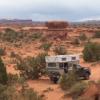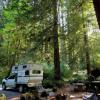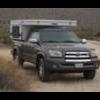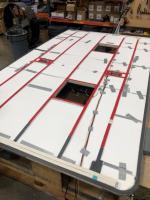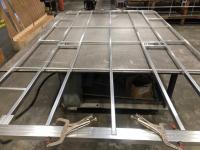FWC Single Sheet Roof "Tin Canning"...Why?
#21

Posted 26 May 2023 - 11:23 AM
This assumes that some of the oil canning is in that central space….. anyone got a wind tunnel in their back yard?
John
#22

Posted 26 May 2023 - 12:48 PM
Just joining in on this thread.
I have a 2022 Hawk Flatbed. I've had this issue since day 1. Nothing on the roof. I do have 2 vents and not sure if it's an issue or more common with 2 vents?
It only happens w/ the wind blowing so I'm assuming the roof is being pushed up slightly. I don't know if it happens w/ the vents open or not but will try that next time (reducing the inside pressure?).
Boise, ID
2022 Chevy 3500 HD
2023 FWC Flatbed Hawk
#23

Posted 26 May 2023 - 01:12 PM
An idea that might address one big floppy spot is to loosen the solar panel, position some hard rubber pieces (or something) so that they get pinched between the panel and roof frame. Retighten the solar panel to trap the rubber pieces. I can’t picture what to use, but the right material could be long enough to restrain a pretty good chunk of the roof without adding penetrations.
This assumes that some of the oil canning is in that central space….. anyone got a wind tunnel in their back yard?
John
Anything trapped between my Zamp panels and the roof to dampen the rood top sheet would put the panels at risk....as the Hawk twists and turns, bounces, on off-road routes the panel would be stressed and that could break the wiring or elements...not worth the risk..
Sail Battens mentioned before come in 34" lengths and if I could figure out where to place them could be the solution...they are stiff and only 1/8 thick.
#24

Posted 26 May 2023 - 01:13 PM
I cringe every time I hear the wind starting to pick up knowing the popping and sleeplessness will start soon. (Yakima tracks with 200W solar panel mounted on L aluminum running east west. 2 vents w fans). When I wash the roof I have studied how it flexes and can see the “waves” or unevenness in the roofs surface. Something I never thought was right but just figured that’s just the way it is an probably only bothered me.
I also have wondered what the heck it does going down the road at highway speeds!
2007 Tundra 5.7L Dbl cab
2020 Hawk Shell
#25

Posted 26 May 2023 - 05:14 PM
We have never experienced the oil canning on our 2014 Hawk that has the single piece roof. Don’t have the Yakima tracks but we do have the factory cargo rack and factory 100 watt Zamp panel.
The factory rack has a full width bar at the front edge of the roof and a full width rack across the rear of the roof. These cross roof aluminum parts are bolted thru the skin & anchor it very securely to the roof skeleton. The rear rack has three full width bars holding the skin down.
I wonder if all these cross supports keep potential flapping to a minimum.
Paul
#26

Posted 26 May 2023 - 07:56 PM
We have never experienced the oil canning on our 2014 Hawk that has the single piece roof. Don’t have the Yakima tracks but we do have the factory cargo rack and factory 100 watt Zamp panel.
The factory rack has a full width bar at the front edge of the roof and a full width rack across the rear of the roof. These cross roof aluminum parts are bolted thru the skin & anchor it very securely to the roof skeleton. The rear rack has three full width bars holding the skin down.
I wonder if all these cross supports keep potential flapping to a minimum.
Paul
Paul,
I do not know what the FWC "cargo racks" look like but your description sounds like they indeed buttoned down the top sheet. Two racks? Front and rear? If I read this correctly you have 5 transverse 'bars' pinning the top sheet down...fore and aft.
My FWC Yakima rails are longitudinal and not full length of top sheet...
To adjudge your set-up, sight down the top sheet from the back and see you can see 'ripples' or 'bellows' in the top sheet or if it is laying flat....mine is anything but flat..
Phil
PS...Just went to FWC website and viewed a photo of your cargo rack....not detailed but...give that photo a look and look at campers in photos...all roofs have ripples/bellows in top sheet; none appear flat...or I could be wrong...
https://fourwheelcam...-dinette/build/
Edited by Wallowa, 26 May 2023 - 08:40 PM.
#27

Posted 26 May 2023 - 08:38 PM
Hello Phil
Sorry for the delay.
We have been on the road for the last week at the Overland Expo in Flagstaff, AZ.
You wrote:
<< How is the roof panel secured to the frame? >>
All of the one-piece smooth aluminum roof skins are attached to the aluminum roof framing with 3M VHB double sided tape.
This tape is very expensive and won't come off. A small roll of 3M VHB tape is approx. $100 (if that helps give you an idea on the quality of the VHB tape). It takes an air chisel for us to remove a roof skin.
There is no way for the aluminum roof skin to come loose. It is not glued. Once the 3M VHB tape is secured, it won't come loose.
On the newer campers, we do glue the foam insulation in the ceiling to the bottom of the roof skin to keep the insulation secure, and also keep it from wiggling (the foam insulation would squeak sometimes in the early days when we didn't glue the insulation to the bottom of the roof skin).
<< Can anything be done to lessen the "tin canning"? >>
Years back, we did have a few customer complaints. But the shop changed a few things and I have not heard of the issue on newer campers for quite a few years. What did they change in the shop back then?? They started gluing the foam insulation to the bottom of the roof skin in the ceiling. What this seems to have done is stop the movement of the aluminum roof skin in-between the roof frame members from moving up and down as much in windy days. We build approx. 1200 - 1300 campers a year. So when there is a problem, we usually hear about it very quickly (due to the volume we do). The oil canning posts have almost disappeared.
From time to time if a showroom camper, a demo camper, or we are at a trade show, and the camper is closed up (windows are closed, window flaps are closed, vents are closed, port holes are closed, etc.) and I push on the soft pop-up fabric from the inside, I can get the camper roof to occasionally "pop" (every once in a while). Basically simulating a windy night.
The only possible things to maybe (maybe?) to try to lessen the "popping" noise would be . . .
(just thinking out loud here)
1. Maybe try opening up one of the turn buckle port holes a little at night (on those windy nights) to allow all of the air inside the camper that is trapped, to come in and out a little (surge in & out a little), instead of pressurizing the air tight interior, which pushes up the roof skin in-between the aluminum roof frame members (oil canning).
2. Try parking the truck in a different direction. For example, if the wind in hitting the side of the camper and the roof is popping, turn the truck and park directly in to the wind. The soft sides of the camper (pop-up fabric) will have a lot less surface area to billow in & out.
3. Maybe leave the soft sides windows bungee cords attached at night to the front and rear windows, to maybe keep the pop-up side a little tighter, so that the pop-up fabric does not billow in & out quite as much on the windy nights ?
4. Last but not least (a last resort effort), maybe glue or VHB tape some flat aluminum stock from side to side on the camper roof. Having flat stock across the roof (side to side) will add some stability and rigidity to the flat aluminum roof skin, maybe (maybe?) reducing the movement of the roof skin in-between the roof frame members. Would be an easy thing to try. No extra holes would be needed in the roof to try this. If there is a downside to this, the only thing I can think of it that it would look a little weird. But ... if you painted the aluminum flat bar white on the top, before securing it to the roof, it would look better (blend in).
5. Maybe bring some small, flat sang bags to lay flay on the roof. I have never heard of any customers trying this, but I think I saw the idea posted in this thread as something to try. This would probably be the last thing I would try.
I will see if I can get some sample pictures to add to this post/thread (later today), to better help with a visual on the ideas mentioned above.
Hope this helps with some ideas.
Stan
___________________________________________________________________________________________________________
I have increased roof "tin canning" during windy conditions. My 2016 Hawk has the single sheet aluminum roof panel. Why this popping of the roof in a wind has been increasing is a mystery.
I do not know how the roof panel is attached to the roof frame of the Hawk. I suspect it is glued to the frame; hence after miles of rough off-roading the glue is failing and the roof panel begins to flap more.
How is the roof panel secured to the frame?
Can anything be done to lessen the "tin canning"?
My Hawk roof has the FWC Yakima rails with two Zamp solar panels [170/160w] and two fans.
Thanks for any insights.
Phil
Stan Kennedy --- Four Wheel Pop-up Campers
1400 Churchill Downs Avenue, Suite A
Woodland, CA 95776
(800) 242-1442 or (530) 666-1442
www.fourwh.com --- e-mail = stan@fourwh.com
#28

Posted 26 May 2023 - 08:49 PM
Stan,
You'll probably get a few responses and not sure exactly how to handle my situation but my 1 year old Flatbed Hawk (which I assume is a newer model so glued insulation) tin cans quite a bit in windy situations. I don't have anything on the roof, 2 vents, etc.
I doubt I'm the only one who has this issue but curious if you have any ideas other than you posted?
Thanks
Kevin
Hello Phil
Sorry for the delay.
We have been on the road for the last week at the Overland Expo in Flagstaff, AZ.
You wrote:
<< How is the roof panel secured to the frame? >>
All of the one-piece smooth aluminum roof skins are attached to the aluminum roof framing with 3M VHB double sided tape.
This tape is very expensive and won't come off. A small roll of 3M VHB tape is approx. $100 (if that helps give you an idea on the quality of the VHB tape). It takes an air chisel for us to remove a roof skin.
There is no way for the aluminum roof skin to come loose. It is not glued. Once the 3M VHB tape is secured, it won't come loose.
On the newer campers, we do glue the foam insulation in the ceiling to the bottom of the roof skin to keep the insulation secure, and also keep it from wiggling (the foam insulation would squeak sometimes in the early days when we didn't glue the insulation to the bottom of the roof skin).
<< Can anything be done to lessen the "tin canning"? >>
Years back, we did have a few customer complaints. But the shop changed a few things and I have not heard of the issue on newer campers for quite a few years. What did they change in the shop back then?? They started gluing the foam insulation to the bottom of the roof skin in the ceiling. What this seems to have done is stop the movement of the aluminum roof skin in-between the roof frame members from moving up and down as much in windy days. We build approx. 1200 - 1300 campers a year. So when there is a problem, we usually hear about it very quickly (due to the volume we do). The oil canning posts have almost disappeared.
From time to time if a showroom camper, a demo camper, or we are at a trade show, and the camper is closed up (windows are closed, window flaps are closed, vents are closed, port holes are closed, etc.) and I push on the soft pop-up fabric from the inside, I can get the camper roof to occasionally "pop" (every once in a while). Basically simulating a windy night.
The only possible things to maybe (maybe?) to try to lessen the "popping" noise would be . . .
(just thinking out loud here)
1. Maybe try opening up one of the turn buckle port holes a little at night (on those windy nights) to allow all of the air inside the camper that is trapped, to come in and out a little (surge in & out a little), instead of pressurizing the air tight interior, which pushes up the roof skin in-between the aluminum roof frame members (oil canning).
2. Try parking the truck in a different direction. For example, if the wind in hitting the side of the camper and the roof is popping, turn the truck and park directly in to the wind. The soft sides of the camper (pop-up fabric) will have a lot less surface area to billow in & out.
3. Maybe leave the soft sides windows bungee cords attached at night to the front and rear windows, to maybe keep the pop-up side a little tighter, so that the pop-up fabric does not billow in & out quite as much on the windy nights ?
4. Last but not least (a last resort effort), maybe glue or VHB tape some flat aluminum stock from side to side on the camper roof. Having flat stock across the roof (side to side) will add some stability and rigidity to the flat aluminum roof skin, maybe (maybe?) reducing the movement of the roof skin in-between the roof frame members. Would be an easy thing to try. No extra holes would be needed in the roof to try this. If there is a downside to this, the only thing I can think of it that it would look a little weird. But ... if you painted the aluminum flat bar white on the top, before securing it to the roof, it would look better (blend in).
5. Maybe bring some small, flat sang bags to lay flay on the roof. I have never heard of any customers trying this, but I think I saw the idea posted in this thread as something to try. This would probably be the last thing I would try.
I will see if I can get some sample pictures to add to this post/thread (later today), to better help with a visual on the ideas mentioned above.
Hope this helps with some ideas.
Stan
___________________________________________________________________________________________________________
Boise, ID
2022 Chevy 3500 HD
2023 FWC Flatbed Hawk
#29

Posted 26 May 2023 - 09:07 PM
Stan,
Hello Phil
Sorry for the delay.
We have been on the road for the last week at the Overland Expo in Flagstaff, AZ.
You wrote:
<< How is the roof panel secured to the frame? >>
All of the one-piece smooth aluminum roof skins are attached to the aluminum roof framing with 3M VHB double sided tape.
This tape is very expensive and won't come off. A small roll of 3M VHB tape is approx. $100 (if that helps give you an idea on the quality of the VHB tape). It takes an air chisel for us to remove a roof skin.
There is no way for the aluminum roof skin to come loose. It is not glued. Once the 3M VHB tape is secured, it won't come loose.
On the newer campers, we do glue the foam insulation in the ceiling to the bottom of the roof skin to keep the insulation secure, and also keep it from wiggling (the foam insulation would squeak sometimes in the early days when we didn't glue the insulation to the bottom of the roof skin).
<< Can anything be done to lessen the "tin canning"? >>
Years back, we did have a few customer complaints. But the shop changed a few things and I have not heard of the issue on newer campers for quite a few years. What did they change in the shop back then?? They started gluing the foam insulation to the bottom of the roof skin in the ceiling. What this seems to have done is stop the movement of the aluminum roof skin in-between the roof frame members from moving up and down as much in windy days. We build approx. 1200 - 1300 campers a year. So when there is a problem, we usually hear about it very quickly (due to the volume we do). The oil canning posts have almost disappeared.
From time to time if a showroom camper, a demo camper, or we are at a trade show, and the camper is closed up (windows are closed, window flaps are closed, vents are closed, port holes are closed, etc.) and I push on the soft pop-up fabric from the inside, I can get the camper roof to occasionally "pop" (every once in a while). Basically simulating a windy night.
The only possible things to maybe (maybe?) to try to lessen the "popping" noise would be . . .
(just thinking out loud here)
1. Maybe try opening up one of the turn buckle port holes a little at night (on those windy nights) to allow all of the air inside the camper that is trapped, to come in and out a little (surge in & out a little), instead of pressurizing the air tight interior, which pushes up the roof skin in-between the aluminum roof frame members (oil canning).
2. Try parking the truck in a different direction. For example, if the wind in hitting the side of the camper and the roof is popping, turn the truck and park directly in to the wind. The soft sides of the camper (pop-up fabric) will have a lot less surface area to billow in & out.
3. Maybe leave the soft sides windows bungee cords attached at night to the front and rear windows, to maybe keep the pop-up side a little tighter, so that the pop-up fabric does not billow in & out quite as much on the windy nights ?
4. Last but not least (a last resort effort), maybe glue or VHB tape some flat aluminum stock from side to side on the camper roof. Having flat stock across the roof (side to side) will add some stability and rigidity to the flat aluminum roof skin, maybe (maybe?) reducing the movement of the roof skin in-between the roof frame members. Would be an easy thing to try. No extra holes would be needed in the roof to try this. If there is a downside to this, the only thing I can think of it that it would look a little weird. But ... if you painted the aluminum flat bar white on the top, before securing it to the roof, it would look better (blend in).
5. Maybe bring some small, flat sang bags to lay flay on the roof. I have never heard of any customers trying this, but I think I saw the idea posted in this thread as something to try. This would probably be the last thing I would try.
I will see if I can get some sample pictures to add to this post/thread (later today), to better help with a visual on the ideas mentioned above.
Hope this helps with some ideas.
Stan
_________________________________________________________________________________________
Stan,
Thanks for the thoughtful reply; as always you step-up ...Do see posts #22 [2022] / #24 [2020]; newer campers are oil canning...not sure when you started gluing insulation to top sheet which indeed would stiffen it...opening interior does not stop canning; we sleep with both roof vents cracked slightly....repositions the camper is not a realistic options in most locations where we disperse camp and trying to second guess the wind is a non-starter...I will give Sage's recommended sail battens a try, not really concerned with how it looks we just need to stop the booming/cracking and popping when trying to sleep..battens are fiberglass and 1/8" thick...why the VHB does not stop canning is a mystery; if intact...I am trying not to add too much weight to the top sheet; but if battens do not work I may consider aluminum strips...my suggestion of sand bags may or may not work; I will also experiment first with them..
For whatever reason, the single piece top sheets often oil can and create enough racket to prevent owners from sleeping...what years? All I know is at least 2016 [mine] to 2022 [#22]....it indeed remains an issue.
Look at camper top sheet in center photo at roof rack option page on FWC website...top sheets are not flat but are bubbled as evidenced by reflected lights on the tops...I could be wrong, but I do know my top sheet is anything but flat...manufactured that way or did the pounding and jarring off roading we have done popped the top sheet loose from VHB? I can attest that the top sheet is not solidly attached to aluminum roof ribs.
I do not look to FWC to "fix" my top sheet; that is up to me and of course I love a challenge! Any suggestions will be tried.
Thanks again for responding....Phil
Edited by Wallowa, 26 May 2023 - 09:11 PM.
#30

Posted 26 May 2023 - 09:22 PM
Sample pictures of the aluminum roof frame and the VHB tape on the frame members.
Stan Kennedy --- Four Wheel Pop-up Campers
1400 Churchill Downs Avenue, Suite A
Woodland, CA 95776
(800) 242-1442 or (530) 666-1442
www.fourwh.com --- e-mail = stan@fourwh.com
0 user(s) are reading this topic
0 members, 0 guests, 0 anonymous users



